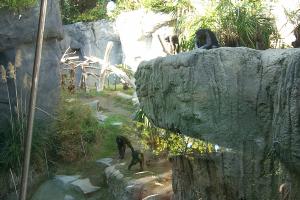| William H. Calvin |
|
The Bonobo Page
William
H. Calvin is a
|
 |
The best book around on bonobos is
probably
Frans de Waal,
Bonobo: The Forgotten Ape
(University of California Press 1997)
with excellent photographs by Frans Lanting.
|
View the BBC's
excellent program (in streaming video) on the threat to the African apes
from the bushmeat trade.
|
Many people do not know the difference between a monkey and an ape. The six remaining ape species (gibbon, siamang, orangutan, gorilla, chimpanzee, and bonobo) all live quite close to the equator, in either Africa or southeast Asia and its offshore islands.
Apes last shared a common ancestor with the Old World Humans evolved from an ape species that existed about 5-6 million years ago, as did the common chimpanzee and the bonobo. (See my book, A Brain for All Seasons, and the San Diego Zoo bonobo page.) |
Bonobo Protection Fund
Bonobos live in the wild in only one section of the Congo River basin of the Democratic Republic of Congo (ex-Zaire), unlike the common chimps which range from the East African Rift Valley to westernmost Africa.
See the Pan Africa News article on human hunting of bonobos, entitled: "Economic Difficulties in Zaire and the Disappearing Taboo against Hunting Bonobos in the Wamba Area." An excerpt:
The Bonobo Protection Fund works to secure some protection for them, including hiring off-duty guards from a nearby national park. Contributions may be made to:
|
From an earlier pre-downsizing Cincinnati Zoo web page:
|
[The appearance of bonobos make them] the most human-like of all apes. Their stride, their stance, their resting postures, their gestures, and their facial expressions all look more like our own than those of chimpanzees, gorillas or orangutans. Often, in the forest, large groups of 200 to 300 individuals come together for what appear to be "visits." During such times, there is almost constant "talking" or vocal exchange, as though they are catching up on past gossip---however, we really do not know, as study of these apes is barely in its infancy.
--from the Bonobo Protection Fund |
Zoo Exhibits of Bonobos
Americas: Morelia (Mexico, 3 bonobos), San Diego Zoo (9) and Wild Animal Park (CA: 6), Cincinnati OH (6), Columbus OH (11), Fort Worth TX(3), Milwaukee WI(11). Not accessible to the public are the 5 bonobos at the Yerkes Regional Primate Research Center and the 8 at the Language Research Center of Georgia State University. The total number of bonobos at zoos and research institutions is only 106, worldwide. |
Columbus Zoohas 11 bonobos (as of August 2000):
Planckendael (outside Antwerp, Belgium)A large, easily-viewed outdoor island, complete with wading opportunities for the bonobos. It is combined with an indoor space that is both interesting to the bonobos and easily seen by the visitor from either above or at floor level (access via the waterfall path). Nine bonobos. (Information from W. H. Calvin visit, 3 June 1995).
San Diego Zoo
If you haven't seen the bonobo exhibit at the main zoo (caution, it is impossible to find anything on their web site) in a few years, you have a treat in store, as they have constructed a magnificent exhibit (visit, October 1999). |
|
The New York Times article of 22 April 1997, "Bonobo Society: Amicable, Amorous and Run by Females." Some quotes:
Even today there are only about 100 in zoos around the country, compared with the many thousands of chimpanzees in captivity. Bonobos are closely related to chimpanzees, but they have a more graceful and slender build, with smaller heads, slimmer necks, longer legs and less burly upper torsos. When standing or walking upright, bonobos have straighter backs than do the chimpanzees, and so assume a more humanlike posture. Far more dramatic than their physical differences are their behavioral distinctions. Bonobos are much less aggressive and hot-tempered than are chimpanzees, and are not nearly as prone to physical violence. They are less obsessed with power and status than are their chimpanzee cousins, and more consumed with Eros. As de Waal puts it in his book, "The chimpanzee resolves sexual issues with power; the bonobo resolves power issues with sex." Or more coyly, chimpanzees are from Mars, bonobos are from Venus. |
FURTHER READING
The New York Times article (April 1998) on bonobo language abilities. The New York Times article (February 1998) on bonobo symbolic communication in the wild.
Frans de Waal's excellent article on bonobo sex and society (Scientific American, March 1995) has the following suggestions for further reading:
|
|
Page maintained by at the University of Washington, Seattle. Revised
2004.
|
Web links to Bonobos
|
COPY-AND-PASTE CITATION William H. Calvin, "Bonobos: The Left Bank Chimpanzees." Available at http://WilliamCalvin.com/teaching/bonobo.htm.
|
University of Washington
Home || Publications
|





 Sue Savage-Rumbaugh and Roger Lewin,
Sue Savage-Rumbaugh and Roger Lewin, 